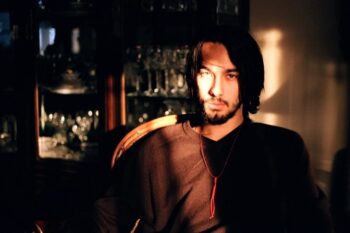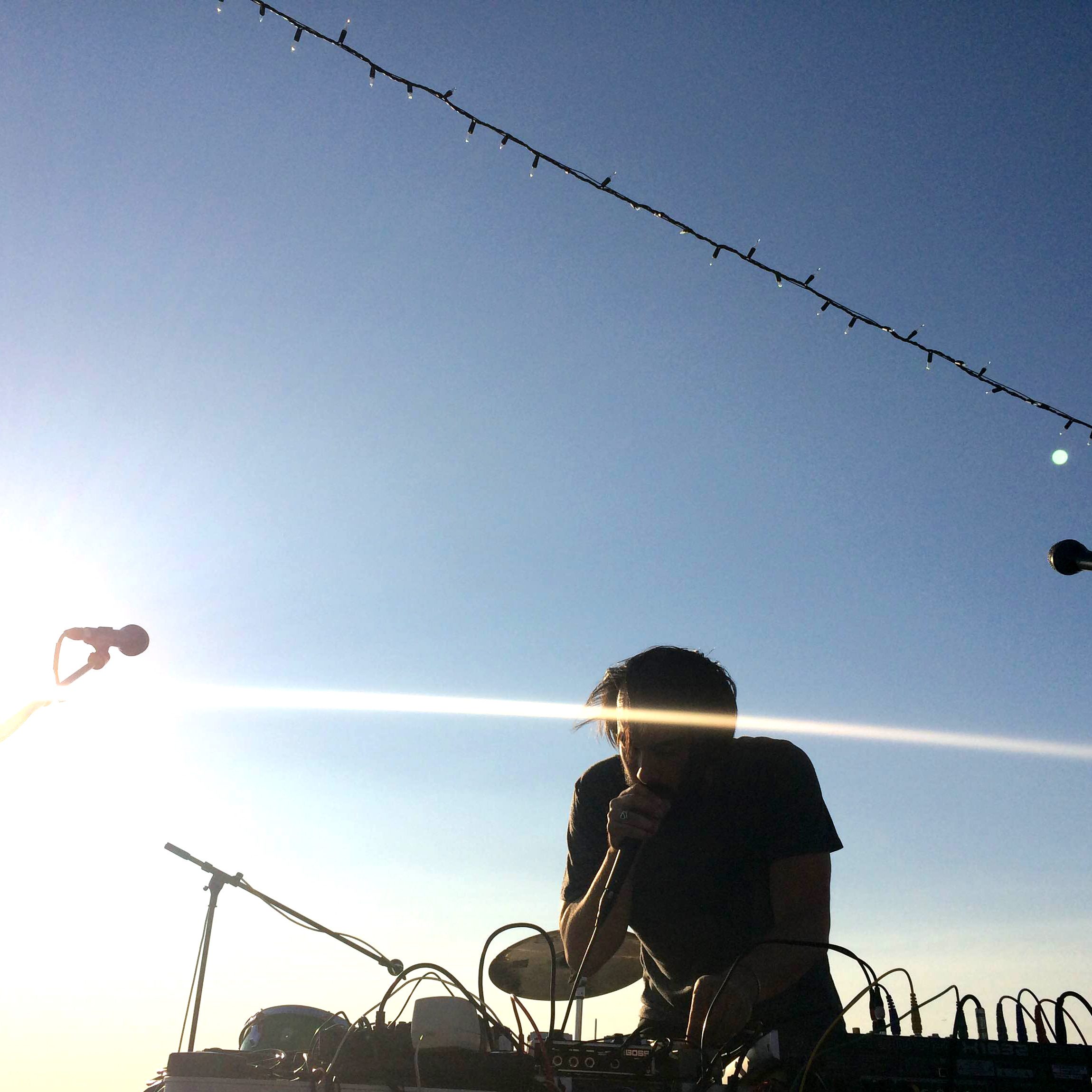
Fresh off of composing the music and sound for Chambre at the New Museum, musician and producer Roarke Menzies released his debut album Shapes in October.
The tracks on Shapes are minimalist works that incorporate abstract vocal tones and shifting sound masses. They may evoke dreams, memories, or spectral presences that gather and disperse, while disorienting listeners’ sense of space, mood, and time. The album is available on major digital retailers, as well as on a limited edition cassette from a new imprint called Coup de Glotte (CdG).
Musicians can occasionally be a frustrating interview, giving elusive one-word answers out of indifference or an inability to verbalize feelings about their music and sounds. That’s not the case with Menzies. In this interview, conducted over email, he was articulate and precise. We talked about his inspirations, process, practice, and how the album came to be.
***
The Rumpus: Since you’ve been composing music for years for theater performances, games, films, television, and art installations, I was surprised to learn this was your debut album. What made you decide that an album was the project to do now?
Roarke Menzies: Yeah, it’s kind of funny. This ‘debut’ is sort of a long time coming, as some of my close friends or family can attest. Over the years I’ve had many different solo projects of many different kinds and a few times have come quite close to finishing albums. But I’m a pretty severe editor and always at some point either the inspiration dries up, or my taste shifts, or, as has often been the case in recent years, someone approaches me about something more time-sensitive (and perhaps better paying), like a commission for a dance score or a video project, and I’ll once again put my solo work on the back burner.
This particular collection started to come together when, some time earlier this year or last, I was feeling like I didn’t have a good enough “reel” or portfolio to represent my work online. In the process of digging through recent recordings, I was just struck by how much intriguing material was sitting there unused from various projects or spontaneous recording sessions. So, I was doing a lot of juggling on iTunes playlists, and then ended up going back to these sessions in Pro Tools, isolating specific tracks and creating new versions, pushing the ideas further. Eventually, I said, “Ok, this isn’t just a portfolio. This is its own entity and I want to do something special with it.”
Rumpus: So some of the material (or at least musical ideas) on this album dates from a while ago and was revisited for this project?
Menzies: Yeah, when I was deciding what to include I was indiscriminate about when the sessions originated. I was focused more on the kinds of sounds I wanted to include and what felt like it fit.
In some cases I was surprised to find out when the earliest version of a track was recorded (and where I was living at the time), etc. There’s actually material on here spanning five years. But in each case there are versions, even before the 2015 versions, where I revisited the material at various points and added to it or tried new things with it. So there’s sort of an off-and-on continuity.
Five years is a long time, but it’s actually not that unusual for albums, especially first albums, to take that long or longer to come out.
Rumpus: I feel every musician is asked to name their influences in interviews, but since your music is pretty abstract, I’d be interested in knowing what yours are. What influenced the tracks on Shapes? Other musicians and sound artists, but also books/films/other types of art? Or what about your own memories or experiences?
Menzies: My family moved around quite a lot when I was a kid. Some of my most vivid memories from childhood are from long, cross country road trips. Music was a central part of that experience. We’d always have albums on or pick up different weird radio stations as we’d pass by cities, towns or college campuses.
 As far as other artists, I have to mention Steve Reich, especially his early tape compositions and phase works, Pierre Schaeffer and Pauline Oliveros. Also, even though they’ve been making brilliant stuff for a long time, I only recently discovered Tim Hecker, William Basinski, and Oneohtrix Point Never, each of whom have become favorites of mine. There’s also the poet Anne Carson and the choreographer Anne Teresa De Keersmaeker.
As far as other artists, I have to mention Steve Reich, especially his early tape compositions and phase works, Pierre Schaeffer and Pauline Oliveros. Also, even though they’ve been making brilliant stuff for a long time, I only recently discovered Tim Hecker, William Basinski, and Oneohtrix Point Never, each of whom have become favorites of mine. There’s also the poet Anne Carson and the choreographer Anne Teresa De Keersmaeker.
But I’d say one of my biggest influences as far as how I think about or frame my work is a book called Audio Culture. It’s a collection of essays and articles edited by Christoph Cox and Daniel Warner that includes writings by and about John Cage, Edgard Varese, Aphex Twin, Yasunao Tone, King Tubby, Christian Marclay, and many others. I read a lot of nonfiction texts on music and sound studies. It’s kind of an independent study that I consider to be an integral part of my studio practice. Brandon Labelle’s Background Noise: Perspectives on Sound Art was another important text for me in that regard.
While putting together the collection that became Shapes, I was reading a book called Sonic Experience: A Guide to Everyday Sounds. It was developed by an interdisciplinary team of architects, philosophers, musicologists, urban planners, cultural theorists, etc., from the Centre for Research on Sonic Space and the Urban Environment at the National School of Architecture in Grenoble. The book aims to define a lexicon of ‘sonic effects’ for use in various fields. I found the writing and clarity of ideas incredibly inspiring and also empowering in that it articulates phenomena you already experience, and gives you ways to talk and think about them.
For instance, this is from the entry on anamnesis:
An effect of reminiscence in which a past situation or atmosphere is brought back to the listener’s consciousness, provoked by a particular signal or sonic context. Anamnesis, a semiotic effect, is the often involuntary revival of memory caused by listening and the evocative power of sounds… This effect can span very different periods of time while retaining its intrinsic nature: it can happen on the scale of an entire life — a song that evokes a childhood memory — or a short span of time — for example, when a film soundtrack plays on the exposition of a sound element previously heard. … The particular timbre of a voice recalls a specific person; a certain song allows one to revisit a day in the past; a particular ambiance evokes memories of years past. Thanks to sound, a forgotten moment of our life is restored.
Rumpus: Let’s talk straight-up gear. What are the tools you are using to make these tracks? Do you have a studio space set up in your apartment or were you going elsewhere to record? I believe some of the sounds are your own voice, manipulated in some way, and I’d be interested in hearing more about that too, since I think a lot of people might not guess that at first listen.
Menzies: Sure. I’ve had a few different rehearsal spaces over the years which I’ve used to record, but at the moment and for the most part, I keep a project space in my apartment where I do all my recording.
I run a microphone through a series of audio pedals including pitch shifters (Boss PS-5, TC Helicon C1), reverb (RV-5), delay (Boss DD-20), EQ (GE-7), and a loop station (Roland RC-50). I vocalize into the mic, make fricative, percussive sounds with my mouth, or sometimes bang or tap on objects like a water glass or my desk or whatever’s nearby. While doing that I can manipulate the settings on the pedals to create different timbres, rhythms, or layers of tones or textures.
I record these performances into Pro Tools, where I then select, manipulate and collage different audio sequences together, sometimes making drastic changes, other times barely touching the recording. Then I can go back and record new material to correspond with the edits I’ve made in Pro Tools, or if it feels complete leave it as is.
All of the tracks on Shapes were made that way, with the exception of “Drones for La Monte Young,” which was made using only a software synthesizer, and “Pulse Inflections” which was made using only a field recording and a metronome running through a delay unit.
 Rumpus: If you could pick an ideal environment (whether that be place, time, mood, etc.), how would a potential listener experience Shapes?
Rumpus: If you could pick an ideal environment (whether that be place, time, mood, etc.), how would a potential listener experience Shapes?
Menzies: Having listened myself in multiple environments, in different moods, from different playback sources and with different background ambience (in the car with the windows down, on the subway on headphones, in my room with the windows open), I actually enjoy how varied the experience is. Whole compositions seem to morph, with different elements or moments coming to the fore, and different associations and meanings seeming to arise. I really appreciate that.
I will say this, though, and it seems obvious, but to quote a Pitchfork review of a Tim Hecker album:
This is music that benefits from being heard loud and/or on headphones in the same way couches are best experienced by actually sitting down in them instead of just brushing your fingers against the upholstery as you leave the room.
Rumpus: Speaking of an ideal setting, the record’s release was at Bunna Cafe with support from Paul Rome, Katie Mullins, and David Kammerer. Bunna stands out to me as a restaurant that has real atmosphere and a calming, nice environment. What did you like about having the show there? What were the highlights of the evening for you?
Menzies: I love the feel of the room in Bunna. It’s so warm and inviting. I’m a big fan of that kind of listening environment. They also inherited some top-notch speakers when Radio Bushwick closed down. So that makes playing there really satisfying for me. There was a moment during my second piece when I was manipulating these really intense, deep rumbling bass tones and you could hear and feel various objects in the room rattling, like cups, spoons, chairs, etc. I heard a glass shatter over on the far side of the room, I assumed from someone dropping it or knocking it over. Later, Sam, one of the owners at Bunna, told me the glass had just fallen from a shelf on its own. No one had touched it, it was just the sympathetic vibrations. He said when that happened he knew it was a truly magical night.
Another big highlight for me was sitting next to Sinedu, one of the members of the Bunna crew, while she performed a traditional Ethiopian coffee ceremony. The smoke and all the scents were rising and spreading throughout the room while David and then Katie were playing. It was beautiful and transporting. And then there’s SK Kakraba, who joined the bill last-minute as a special guest. He’s an incredible Ghanaian gyli (xylophone) virtuoso who happened to be in town promoting his new record on Awesome Tapes From Africa. His sense of time and dynamics are unreal, and he plays with so much feeling and with such a deep connection to his instrument, which he fabricates himself. I’m so honored to have hosted such a unique talent. I have to thank my good friend Mike Visser (of Imaginary Tricks) for arranging that appearance.
Rumpus: During your set, were you actually playing any of the tracks on Shapes “live” or some variation of them live? How much of what you do up there is pre-planned out and how much is what you’re feeling in the moment or your own reading of the room?
Menzies: I actually ended up deciding not to replicate any of the material from Shapes but to instead make something totally unique for this event. I did two short performances. The first was a structured sort of lyrical/melodic vocal improvisation that I call “February,” because I performed it for the first time one February, and the other was a more spontaneous improvisation that came together in the moment. There’s something singularly exciting to me about building a sound performance from scratch that way in front of an audience. It’s one of my favorite things.
***
Feature photo © Michael Hart. Performance photo © Precede/Proceed.




